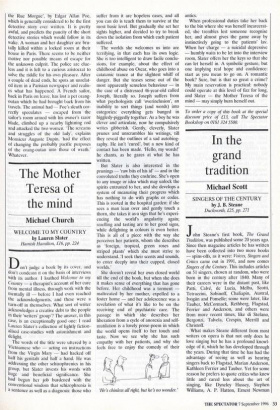In the grand tradition
Michael Scott
SINGERS OF THE CENTURY by J. B. Steane Duckworth, £25, pp. 271 John Steane's first book, The Grand Tradition, was published some 20 years ago. Since then magazine articles he has written have been collected into two more books — spins-offs, as it were: Voices, Singers and Critics came out in 1991, and now comes Singers of the Century. This includes articles on 51 singers, chosen at random, who were born in the century after 1840. Many of their careers were in the distant past, like Patti, Calve, de Lucia, Melba, Scotti, Tetrazzini, Sobinoff, Chaliapin, Austral, Ivogiin and Ponselle; some were later, like Tauber, McCormack, Rethberg, Flagstad, Ferrier and Anderson, and others were from more recent times, like di Stefano, Bergonzi, Talvela, Crespin, Merrill and Christoff.
What makes Steane different from most writers on opera is that not only does he love singing but he has a profound knowl- edge of it, which he has developed through the years. During that time he has had the advantage of seeing as well as hearing singers back to Flagstad, Marian Anderson, Kathleen Ferrier and Tauber. Yet for some reason he prefers to quote critics who knew little and cared less about the art of singing, like Dyneley Hussey, Stephen Williams, A. P. Hatton, Ernest Newman and Harold Rosenthal. It could be argued that it is their order of priorities that have contributed to the crisis in opera singing today. They forgot that singers are more essential to opera than conductors, orches- tras or stage directors.
The decline in the art of singing is one of the main reasons for the decline in opera's vitality. During the 19th century, when popular operas were still being written, save for a handful of hardy perennials, the bulk of the repertory was written within the preceding generation, whereas now it is at least a century old. Which is perhaps the reason why Steane finds himself so much in demand — with his retrospective knowl- edge, experience and enthusiasm. Not that this does not have its disadvantages. In his youth he was much taken up with singers whose charm accounted for their reputa- tion. Somewhat disingenuously, he fails to note their faulty technique which inevitably compromised their musicianship — like Galli-Curers sketchy execution and approx- imate intonation, Schumann's slitherings and slidings, or Farrar's attempt to inflate her naturally lyric soprano. These judg- ments are confirmed by the New York crit- ic, W. J. Henderson, author of The Art of Singing, whom Steane quotes, although not very affectionately, or completely, which is a pity, for he knew and cared deeply about singing.
Naturally some singers Steane seems to like more than others. Of Victoria de los Angeles he writes 'the voice in its prime was so pure and opulent'; the enchantment of [Joan Cross's] singing, the emotion of her acting, and the beauty of her appear- ance'; 'Talvela was (and is), in short one of the great singers of the century.' Whereas he claims, 'Crespin's voice, as heard in Covent Garden, had never seemed to me a beautiful one'; 'some singers ... lay up store for autumn [but] for di Stefano ... autumn was not a good season'; McCorma- ck's slightly thin, somewhat nasal quality [singing Handel's 'Where'er you walk'], the habit of taking notes from just a little below, and the tendency to close the vowel prematurely deprived his phrasing of its true singing qual- ity.
Occasionally Steane gets a little out- spoken, for example, on the subject of Jon Vickers. I too remember Vickers as Jason in Cherubini's Medea, his incessant pranc- ing around, wearing skin-coloured tights, and how self-consciously careful he was always to put one foot in front of the other — presumably so nobody would notice how bow-legged he was. Steane tells us Vickers had 'moral and religious' objections to Tannhiiuser — and presumably Siegfried too, for he never ventured it — yet he sang Parsifall One does not need to be very cyni- cal to believe the real reason he did not sing them was because his technique was 'imperfect and he dared not risk the expo- sure. He had a disagreeable way of grazing up to high notes, a problem of support,
common enough with a big voice, which explains why when singing softly, as Steane notes, he could have been accused of crooning.
Curiously Steane recognises this as a fault in Vickers' technique but not in Fischer-Dieskau's. He gets quite aerated about objections to Fischer-Dieskau's style sounding 'studied' being 'bunkum'. He claims his voice makes beautiful sounds, and is impressed by how smooth a line he can draw. However, the same might be said of Sinatra; for Fischer-Dieskau's effects, like Sinatra's, are contrived without sup- porting his voice — which is why his singing does sound 'studied'. Steane argues that he has never heard Fischer-Dieskau sing without 'learning' something. He goes on: 'Learning comes from feeling, [and] there is no dichotomy here'. But learning involves cerebration and must be self-con- scious; there is nothing spontaneous about it, which is what great singing should be.
It is the spontaneous effect, 'an Joan Cross as Queen Elizabeth in Gloriana
unaccountable moistening of the eyes', which Steane finds irresistible when listen- ing to Melba sing Szulc's Claire de lune. And what applies to Szulc should apply to Schubert too. In the 19th century songs were sung by singers with fully supported voices. It was not until after the invention of the microphone that Fischer-Dieskau (like Sinatra) established himself. What- ever else Fischer-Dieskau's interpretations are they are certainly not stylish. Steane knows the Lieder recordings of Schlusnus. Not only is his voice beautiful, but he always sings beautifully — 'be] canto', in other words — which no one would attempt to claim Fischer-Dieskau does.



























































 Previous page
Previous page